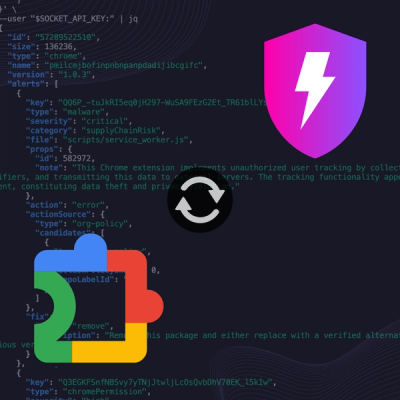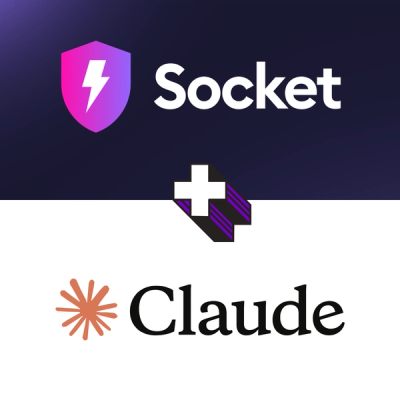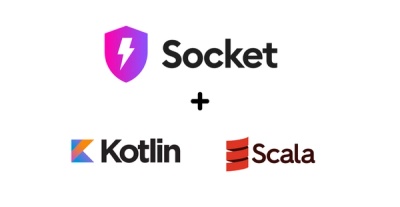
Product
Socket Now Protects the Chrome Extension Ecosystem
Socket is launching experimental protection for Chrome extensions, scanning for malware and risky permissions to prevent silent supply chain attacks.
youtube-player
Advanced tools
The youtube-player npm package is a simple wrapper around the YouTube IFrame Player API, allowing you to easily embed and control YouTube videos in your web applications.
Load a YouTube Video
This feature allows you to load a YouTube video by its ID into an HTML element with the specified ID. In this example, the video with ID 'M7lc1UVf-VE' is loaded into the element with ID 'video-player'.
const YouTubePlayer = require('youtube-player');
const player = YouTubePlayer('video-player');
player.loadVideoById('M7lc1UVf-VE');Play a Video
This feature allows you to play the currently loaded video. The `playVideo` method starts the video playback.
player.playVideo();Pause a Video
This feature allows you to pause the currently playing video. The `pauseVideo` method pauses the video playback.
player.pauseVideo();Seek to a Specific Time
This feature allows you to seek to a specific time in the video. The `seekTo` method takes the time in seconds and a boolean indicating whether to allow seeking ahead of the video.
player.seekTo(30, true);Get Video Duration
This feature allows you to get the duration of the currently loaded video. The `getDuration` method returns a promise that resolves with the duration in seconds.
player.getDuration().then(duration => console.log(duration));The react-youtube package is a React component for embedding YouTube videos. It provides a declarative way to embed and control YouTube videos in React applications. Compared to youtube-player, react-youtube is more suitable for React-based projects and offers a more React-friendly API.
The youtube-iframe package is a lightweight wrapper around the YouTube IFrame Player API. It provides similar functionalities to youtube-player but with a simpler and more minimalistic approach. It is suitable for projects that require basic YouTube video embedding and control without additional features.
The youtube-api package is a comprehensive wrapper around the YouTube Data API. It allows you to interact with various YouTube services, including video playback, uploading, and data retrieval. While it offers more extensive functionalities compared to youtube-player, it is more complex and suitable for projects that require deep integration with YouTube services.
youtube-player is an abstraction of YouTube IFrame Player API (YIPA).
The downsides of using YouTube IFrame Player API are:
window).youtube-player:
/**
* @typedef options
* @see https://developers.google.com/youtube/iframe_api_reference#Loading_a_Video_Player
* @param {Number} width
* @param {Number} height
* @param {String} videoId
* @param {Object} playerVars
* @param {Object} events
*/
/**
* @typedef YT.Player
* @see https://developers.google.com/youtube/iframe_api_reference
* */
/**
* A factory function used to produce an instance of YT.Player and queue function calls and proxy events of the resulting object.
*
* @param {YT.Player|HTMLElement|String} elementId Either An existing YT.Player instance,
* the DOM element or the id of the HTML element where the API will insert an <iframe>.
* @param {YouTubePlayer~options} options See `options` (Ignored when using an existing YT.Player instance).
* @param {boolean} strictState A flag designating whether or not to wait for
* an acceptable state when calling supported functions. Default: `false`.
* See `FunctionStateMap.js` for supported functions and acceptable states.
* @returns {Object}
*/
import YouTubePlayer from 'youtube-player';
youtube-player is a factory function.
The resulting object exposes all functions of an instance of YT.Player. The difference is that the function body is wrapped in a promise. This promise is resolved only when the player has finished loading and is ready to begin receiving API calls (onReady). Therefore, all function calls are queued and replayed only when player is ready.
This encapsulation does not affect the API other than making every function return a promise.
let player;
player = YouTubePlayer('video-player');
// 'loadVideoById' is queued until the player is ready to receive API calls.
player.loadVideoById('M7lc1UVf-VE');
// 'playVideo' is queue until the player is ready to received API calls and after 'loadVideoById' has been called.
player.playVideo();
// 'stopVideo' is queued after 'playVideo'.
player
.stopVideo()
.then(() => {
// Every function returns a promise that is resolved after the target function has been executed.
});
player.on event emitter is used to listen to all YouTube IFrame Player API events, e.g.
player.on('stateChange', (event) => {
// event.data
});
player.off removes a previously added event listener, e.g.
var listener = player.on(/* ... */);
player.off(listener);
Note that the built version does not inline polyfills.
You need to polyfill the environment locally (e.g. using a service such as https://polyfill.io/v2/docs/).
youtube-player is using debug module to expose debugging information.
The debug namespace is "youtube-player".
To display youtube-player logs configure localStorage.debug, e.g.
localStorage.debug = 'youtube-player:*';
Using NPM:
npm install youtube-player
npm install
npm run build
cd ./examples
npm install
npm run start
This will start a HTTP server on port 8000.
FAQs
YouTube IFrame Player API abstraction.
The npm package youtube-player receives a total of 499,300 weekly downloads. As such, youtube-player popularity was classified as popular.
We found that youtube-player demonstrated a not healthy version release cadence and project activity because the last version was released a year ago. It has 1 open source maintainer collaborating on the project.
Did you know?

Socket for GitHub automatically highlights issues in each pull request and monitors the health of all your open source dependencies. Discover the contents of your packages and block harmful activity before you install or update your dependencies.

Product
Socket is launching experimental protection for Chrome extensions, scanning for malware and risky permissions to prevent silent supply chain attacks.

Product
Add secure dependency scanning to Claude Desktop with Socket MCP, a one-click extension that keeps your coding conversations safe from malicious packages.

Product
Socket now supports Scala and Kotlin, bringing AI-powered threat detection to JVM projects with easy manifest generation and fast, accurate scans.